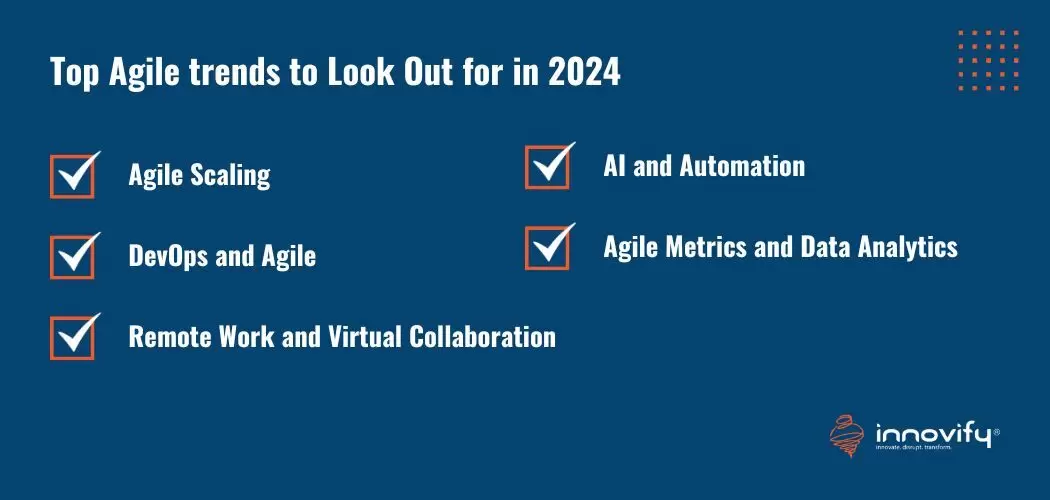AI/ML
Top Agile Trends 2024: Stay ahead with these latest Agile trends
The Future of Agile
In a constantly evolving world, where innovation and adaptability are the currencies of success, the Agile revolution continues to shape how we approach projects, teams, and organizations. As we proceed with 2024, a new chapter in the Agile story unfolds, revealing a tapestry of captivating agile trends pushing collaboration, efficiency, and growth.
Agile methods are still the top choice for many IT and software development teams in 2024. Agile isn’t just a way of doing things – it’s a way of thinking that values flexibility, quick response to change, and constant customer feedback.
2019: the year of the global pandemic- COVID-19 acted as a blessing in disguise. The time has forced every team to work from home, and hence despite this change, Agile has made it easy for teams to work well together, even in different places.
In Agile, what else was exciting in 2023? Well, it is the growing use of artificial intelligence (AI) and automation in agile work. This technology is helping in the advancements of how teams work, also making it easier to make smart decisions and keep projects running smoothly.
As per the enlightening 2022 State of Agile Report, participants were queried about their key focal points when prioritizing integrating Agile practices. The resounding response reveals the following facets:
- A commanding 52% emphasize the urgency to expedite time-to-market.
- Notably, 44% vouch for the indispensable value of predictability.
- Additionally, 31% highlight the crucial need to curtail the risks involved.
As we look ahead, agile methods continue to change and improve, securing their place as critical tools for successful software development. Likewise, let’s put a drop in the bucket by shedding some light on the new trends in Agile methodology with the following sections.
To know more, let the ball rolling.
Top 5 Trends in Agile for 2024
Agile methodologies continue to standardize in 2024, withScrum, Kanban, and SAFe leading the pack in widespread adoption and application across various Agile projects. Agile leadership and culture are also in the limelight, with businesses emphasizing empowering teams to operate autonomously and fostering an environment that encourages continuous improvement.
Undoubtedly, Agile stole the thunder of every other methodology out there. Therefore, here comes the perfect time to quickly look at the latest trends in agile methodology.
Remote Work and Virtual Collaboration
Due to the pandemic, working from home and collaborating virtually has become the new normal. Agile methodologies have adapted well to this change, and we’re seeing increased use of remote collaboration tools such as Slack, Trello, and Jira in Agile environments.
Agile practices are being fine-tuned for remote teams, emphasizing communication and transparency to ensure everyone is on the same page and that there are no bottlenecks in the development process.
AI and Automation
In 2024, AI is making significant inroads in agile project management and decision-making. It is one of the most used trends in agile. AI algorithms can predict project trajectories, identify potential bottlenecks, and provide valuable insights that drive smarter decision-making.
Conversely, automation is taking over routine tasks, thereby increasing efficiency and freeing up team members to focus on more complex, value-added tasks. AI and automation tools are increasingly integrated with Agile practices, enhancing productivity and effectiveness.
Agile Scaling
Adopting Agile methodologies is not limited to IT and software development teams anymore. More and more non-IT projects and enterprises are adopting Agile at a larger scale, recognizing the benefits of increased flexibility, improved customer satisfaction, and better project control. Agile scaling methodologies like SAFe are seeing widespread adoption as they provide a structured framework for applying agile principles across an entire organization.
DevOps and Agile
The convergence of DevOps and Agile practices is a significant trend in 2024. By adopting DevOps principles within Agile development, organizations can break down silos, improve collaboration between development and operations teams, and deliver higher-quality software faster. Tools that facilitate
continuous integration and delivery are becoming integral to this practice, further improving the speed and quality of software development.
Agile Metrics and Data Analytics
Data-driven decision-making is gaining prominence in agile project management. Agile teams are increasingly leveraging metrics and analytics tools to measure the success of their projects and make informed decisions.
Metrics like velocity, burn-down and burn-up charts, and cumulative flow diagrams are being used to track progress, forecast delivery timelines, and identify areas for improvement. Agile analytics tools are being adopted to gather these metrics, analyze them, and provide actionable insights that lead to better project outcomes.
Agile Trends Across Industries in 2024
In a world where change is the only constant, industries across the globe are awakening to the transformative power of Agile methodologies. From technology titans to healthcare pioneers, the Agile revolution is sweeping through diverse sectors, redefining the game’s rules and propelling organizations to new heights of success. In this enlightening exploration, let’s delve into the dynamic landscape of 8 industries where Agile trends are reshaping the very essence of their operations.
Numerous companies are jumping on the bandwagon by adopting agile methodologies or trends in their projects.
Let’s explore the top 8 Agile trends in different industries by hitting the nail.
Agile Methodologies
Agile methodologies have become a go-to strategy across various industries. They’ve gained a lot of popularity because they offer these advantages:
- Faster time-to-market
- Higher customer satisfaction
- Better quality software
- A clearer view of work progress
- Better team cooperation
- Higher employee engagement
For instance, Agile has been instrumental in accelerating the development and rollout of digital health solutions in the healthcare industry. Similarly, Agile has been adopted in the finance sector to drive digital transformation initiatives, delivering new fintech solutions to the market at an unprecedented speed.
Customer-Centricity
Customer-centricity, a core tenet of Agile, has gained significant prominence across industries. Businesses actively engage customers early in development to gather feedback and ensure the developed products or services align with their needs and preferences.
In the retail industry, for example, agile customer-centric approaches have led to the development of personalized shopping experiences, leveraging customer feedback to refine and improve services continually.
Cross-Functional Teams
The rise of cross-functional teams, where members from various departments work together, has been a key Agile trend across industries. This collaboration ensures that projects align with the organization’s strategic goals and meet the needs of all stakeholders.
In the manufacturing industry, cross-functional teams have bridged gaps between design, production, and quality control teams, improving operational efficiency and product quality.
Continuous Feedback
Industries such as education and hospitality utilize Agile’s continuous feedback principle to refine and improve their offerings. By implementing a system of constant feedback, these industries ensure their products and services consistently meet user needs and expectations.
Agile Project Management Tools
Agile project management tools, like Jira and Trello, have seen widespread adoption across industries. These tools enable teams to manage tasks, track progress, and collaborate efficiently, regardless of their physical location.
For instance, in the construction industry, these tools are instrumental in maintaining a steady flow of communication and coordination among architects, engineers, and construction workers.
In marketing, Jira and Trello are used for campaign planning, content scheduling, and stakeholder reporting. It ensures that everyone involved understands the project status and next steps.
Value-Based Prioritization
Value-based prioritization, another core Agile principle, has been widely adopted in marketing and advertising. Teams focus on delivering high-value projects first, enabling faster returns on investment and ensuring that resources are efficiently utilized.
In the software industry, teams prioritize features based on their potential to deliver value to the customer and impact business outcomes.
In the healthcare sector, value-based prioritization might involve focusing on healthcare initiatives with the most significant potential to improve patient outcomes and operational efficiency. These initiatives may include implementing electronic health records or improving patient flow.
Data-Driven Decision Making
Data-driven decision-making is becoming increasingly integral to agile methodologies across industries. It enables organizations to make informed decisions based on accurate, real-time data.
In the logistics and supply chain industry, for example, data-driven decision-making has been used to optimize routes, manage inventory, and forecast demand, significantly improving operational efficiency.
Regulatory Compliance
Industries with strict regulatory requirements, such as pharmaceuticals and banking, find agile methodologies particularly useful. Agile’s inherent flexibility and adaptability allow these organizations to respond swiftly to changing regulatory requirements, ensuring compliance while continuing to innovate.
For example, Agile allows teams to pivot their strategies in the pharmaceutical industry when new regulatory guidelines are introduced, ensuring that drug development processes remain compliant without disrupting progress. Similarly, in the finance sector, agile methodologies enable rapid adjustments to processes and systems in response to evolving financial regulations. It helps prevent compliance breaches and the associated penalties.
Embracing Agile Trends for a Successful 2024 and Beyond
In an era of rapid digital transformation and an increasingly competitive business landscape, adapting to agile trends is more than just a strategic move – it’s necessary for survival and growth. The year 2024 is witnessing an uptick in Agile practices across industries, with businesses integrating AI and automation into Agile methodologies to streamline processes and enhance decision-making.
If you’re interested in integrating Agile methodologies into your business strategy, Innovify is here to help. We offer lean & agile transformation services, aimed at maximizing efficiency. Our approach emphasizes customer-centric solutions, cross-functional collaborations, and continuous feedback loops – key tenets of the Agile philosophy.
Through our services, we’ll help you stay ahead of the curve to ensure that your business is ready to tackle the challenges and opportunities that lie ahead. Reach out to Innovify today to kickstart your agile transformation journey.
FAQs
Q1: What are some key Agile trends to look out for in 2024?
Some key Agile trends to look out for in 2024 include an increased focus on remote collaboration, the adoption of DevSecOps, and the rise of AI-driven Agile project management tools.
Q2: How can Agile methodologies benefit businesses in 2024?
Agile methodologies can benefit businesses in 2024 by fostering adaptability, improving time-to-market, enhancing customer satisfaction, and enabling efficient resource allocation.
Q3: Are there any emerging technologies that will influence Agile practices in 2024?
Emerging technologies like artificial intelligence, machine learning, and robotic process automation will influence Agile practices in 2024, enabling automation, data-driven decision-making, and continuous improvement.
Q4: What are the challenges and opportunities associated with implementing Agile in 2024?
Challenges associated with implementing Agile in 2024 may include organizational resistance to change, scaling Agile in large enterprises, and ensuring effective cross-functional collaboration. However, Agile also presents opportunities for increased innovation, flexibility, and responsiveness to market demands.
Q5: How can businesses leverage Agile trends in 2024 to drive innovation and growth?
Businesses can leverage Agile trends in 2024 to drive innovation and growth by embracing iterative and incremental development, fostering collaboration and continuous learning, and leveraging Agile frameworks such as Scrum and Kanban to deliver value quickly and adapt to changing customer needs.
Q6: What steps can organizations take to align with Agile trends and stay competitive in 2024?
To align with Agile trends and stay competitive in 2024, organizations can take steps such as investing in Agile training and coaching for their teams, embracing Agile Manifesto principles and values throughout the organization, empowering self-organizing teams, promoting transparent communication and feedback loops, and embracing Agile techniques for product development and project management, such as user stories and iterative releases.




